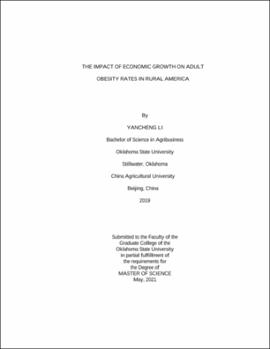| dc.contributor.advisor | Whitacre, Brian | |
| dc.contributor.author | Li, Yancheng | |
| dc.date.accessioned | 2021-09-23T19:51:46Z | |
| dc.date.available | 2021-09-23T19:51:46Z | |
| dc.date.issued | 2021-05 | |
| dc.identifier.uri | https://hdl.handle.net/11244/330851 | |
| dc.description.abstract | In the past several decades, obesity has become an increasingly severe problem in United States. From 2008 to 2018, the adult obesity rate rose from 33.8% to 42.4%. Obesity rates are notably higher in rural America when compared to their urban counterparts. Meanwhile, rural regions have experienced relatively slower employment growth and higher poverty rates during the recovery from the Great Recession. Social scientists are interested in determinants of - and potential solutions to - this rise in obesity rates. The existing literature has focused on the relationship between obesity and social / economic factors, such as the number of fast-food restaurants, limited physical activity, and unemployment rates. However, one unexplored question is whether the level of economic growth experienced by a rural area plays a role in the obesity problem. This paper assesses the impact of economic growth (measured by county-level GDP per capita) on obesity rates (measured by the county-level percentage of adults with BMI higher than 30) in rural America. Nationwide, data is collected on a host of demographic and economic characteristics for all non-metropolitan counties from 2012 to 2016, resulting in a county-level panel data set (n=1,948, t=5). Control variables include age, race and ethnicity, unemployment rates, rates of physical inactivity, and an index measuring healthy food availability. Two different econometric approaches were applied: (1) a fixed effects panel regression model and (2) a difference-in-difference model using propensity score matching (PSM). Under the PSM method, the outcome variable was the difference of obesity growth rates between 2014-2016 and 2012-2014, while the treatment was defined as growth rates in GDP per capita between 2012 and 2014. Different thresholds (such as 5% and 10% growth) were considered for the treatment. The results of both econometric models suggest that higher levels of economic growth in non-metro counties have a surprisingly positive impact on obesity rates in later years. This result is counter to the hypothesis and suggests that programs focused on rural economic growth may lead to undesirable outcomes in other quality-of-life metrics. The conclusion discusses these competing interests and how regional scientists can play a role in future research in this area. | |
| dc.format | application/pdf | |
| dc.language | en_US | |
| dc.rights | Copyright is held by the author who has granted the Oklahoma State University Library the non-exclusive right to share this material in its institutional repository. Contact Digital Library Services at lib-dls@okstate.edu or 405-744-9161 for the permission policy on the use, reproduction or distribution of this material. | |
| dc.title | Impact of economic growth on adult obesity rates in rural America | |
| dc.contributor.committeeMember | Lansford, Notie | |
| dc.contributor.committeeMember | Woods, Mike | |
| osu.filename | Li_okstate_0664M_17106.pdf | |
| osu.accesstype | Open Access | |
| dc.type.genre | Thesis | |
| dc.type.material | Text | |
| dc.subject.keywords | difference-in-difference | |
| dc.subject.keywords | economic development | |
| dc.subject.keywords | fixed effects | |
| dc.subject.keywords | obesity | |
| dc.subject.keywords | propensity score matching | |
| dc.subject.keywords | rural america | |
| thesis.degree.discipline | Agricultural Economics | |
| thesis.degree.grantor | Oklahoma State University | |
